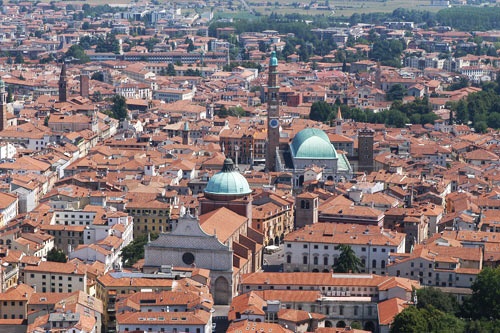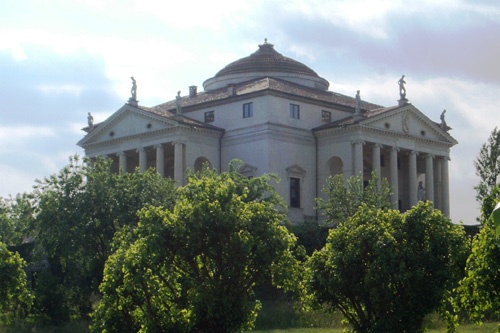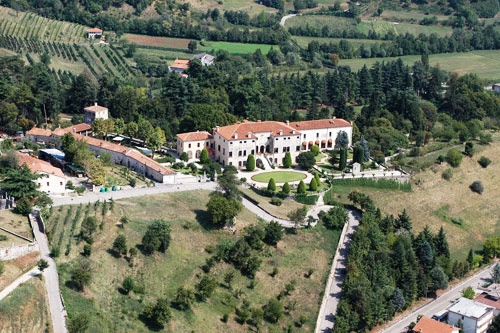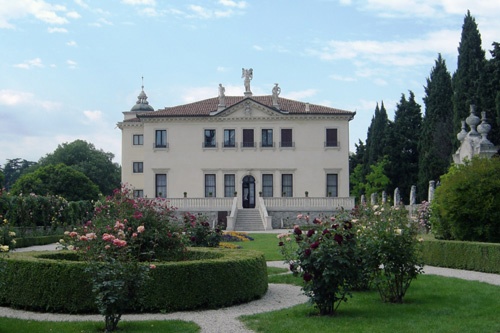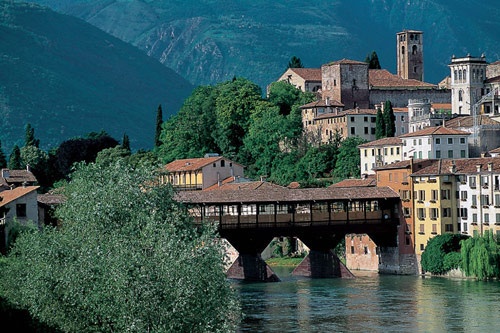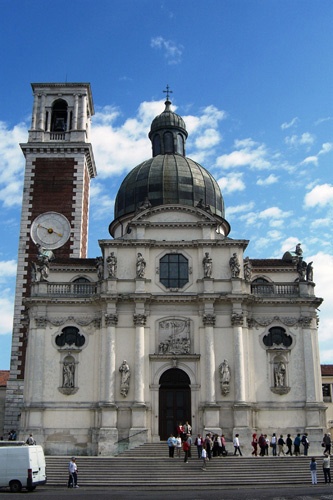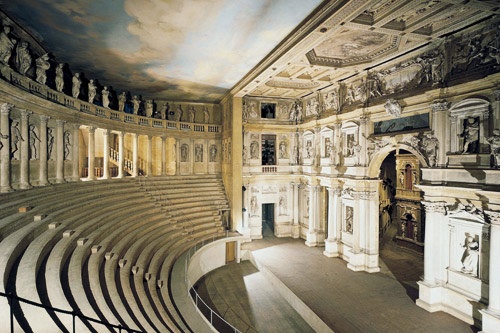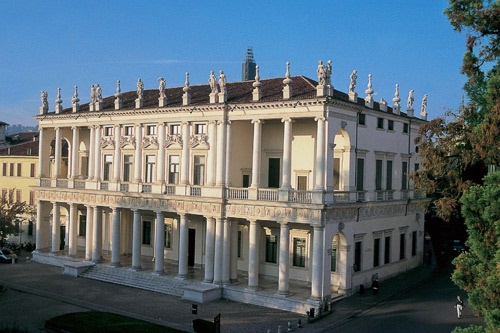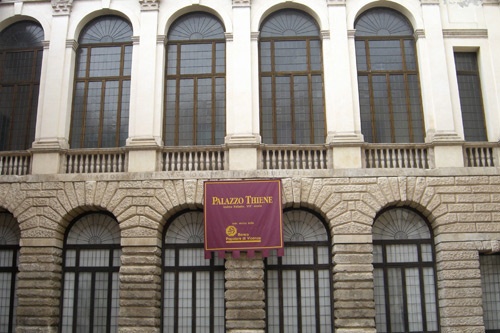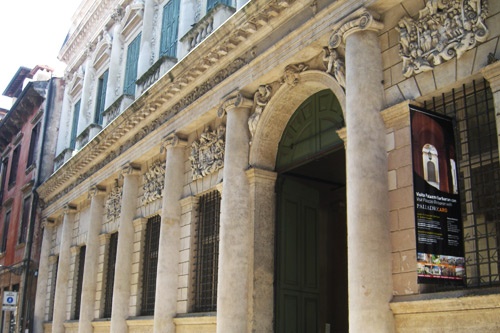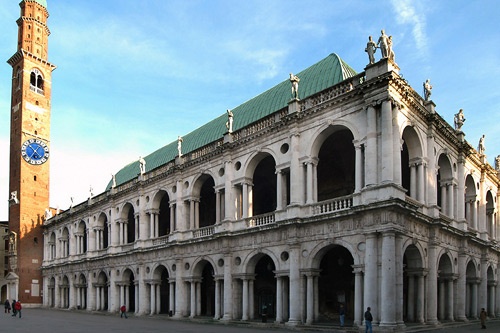Italian Villas: 10 Architectural Wonders in Vicenza
By
Italian Villas, Basilicas, Bridges & More: 10 Architectural Wonders
By Jennifer Polland
For architecture buffs, Italy's Vicenza is synonymous with Andrea Palladio, the great Italian Renaissance architect who prized symmetry and Greco-Roman architectural principles.
Palladio was an incredibly prolific architect, and many of his 16th-century constructions still stand proudly throughout Vicenza, a province in the Veneto region in northern Italy.
The province of Vincenza includes the towns of Bassano del Grappa, Marostica, Thiene, and the capital city of Vicenza. Although the province is renowned for its growing number of vineyards and refined cuisine, Vicenza is best-known for its Palladian villas and palazzi. In fact, in 1994, the entire city of Vicenza was designated as a UNESCO World Heritage Site to protect Palladio's palazzi. In 1996, that designation was expanded to include Palladio's villas that dot Vicenza province and the Veneto region.
Today, visitors can check out many of these treasures, including these 10 architectural highlights.
More Info: Vicenza Convention & Visitor Bureau (tel. 0444-994-770; www.vicenzae.org).
Photo Caption: Vicenza rooftops. Courtesy Consorzio Vicenza è
For architecture buffs, Italy's Vicenza is synonymous with Andrea Palladio, the great Italian Renaissance architect who prized symmetry and Greco-Roman architectural principles.
Palladio was an incredibly prolific architect, and many of his 16th-century constructions still stand proudly throughout Vicenza, a province in the Veneto region in northern Italy.
The province of Vincenza includes the towns of Bassano del Grappa, Marostica, Thiene, and the capital city of Vicenza. Although the province is renowned for its growing number of vineyards and refined cuisine, Vicenza is best-known for its Palladian villas and palazzi. In fact, in 1994, the entire city of Vicenza was designated as a UNESCO World Heritage Site to protect Palladio's palazzi. In 1996, that designation was expanded to include Palladio's villas that dot Vicenza province and the Veneto region.
Today, visitors can check out many of these treasures, including these 10 architectural highlights.
More Info: Vicenza Convention & Visitor Bureau (tel. 0444-994-770; www.vicenzae.org).
Photo Caption: Vicenza rooftops. Courtesy Consorzio Vicenza è
Villa La Rotonda
This building might look familiar -- that's because it served as the inspiration for countless buildings around the world (like Thomas Jefferson's Monticello and Chiswick House outside London). Constructed in the late 16th century, the Villa La Rotonda (tel. 0444-321-793; www.villalarotonda.it) is perhaps Palladio's most iconic construction. Completely symmetrical, the square building has four equal sides, each with an identical projecting portico. In the center is a symmetrical dome. Although Palladio did not live to see the completion of the Villa (he died in 1580, about 40 years before it was completed), this building typifies his architectural style. Located on a scenic hill outside the city of Vicenza, the Villa La Rotonda is protected as a UNESCO World Heritage Site.
How Much: €5 for adults and kids (Tuesdays, Thursday, Fridays, Sundays); €10 on Wednesdays and Saturdays, when you can visit the interior of the building.
Photo Caption: Villa La Rotonda in Vicenza, Italy
How Much: €5 for adults and kids (Tuesdays, Thursday, Fridays, Sundays); €10 on Wednesdays and Saturdays, when you can visit the interior of the building.
Photo Caption: Villa La Rotonda in Vicenza, Italy
Villa Godi Malinverni
The Villa Godi Malinverni (tel. 0445-860-561; www.villagodi.com) was one of Palladio's first constructions, dating back to about 1540. Located in the town of Lugo, this three-story stone villa displays elements of Palladio's typical style -- it's symmetrical and lined up on a single axis -- but it also features some elements that evoke the design of a castle. The Villa Godi Malinverni was built at a time when the Republic of Venice was starting to lose power and people began to move out to the country and build farmhouses (or villas), rather than castles. This villa, which is protected as a UNESCO World Heritage Site, combines elements of both types of constructions, reflecting what was happening at that time. Inside, there are beautiful frescoes by Battista Zelotti that depict scenes from Greek mythology and Greek history. There is also a notable fossil museum here, which is home to a pre-historic 30-foot-tall palm tree.
How Much: €6 for adults; €3 for kids
Photo Caption: Villa Godi Malinverni in Vicenza. Courtesy Consorzio Vicenza è
How Much: €6 for adults; €3 for kids
Photo Caption: Villa Godi Malinverni in Vicenza. Courtesy Consorzio Vicenza è
Villa Valmarana ai Nani
Legend has it that a young dwarf princess lived in seclusion in this villa, the Villa Valmarana ai Nani (tel. 0444-321-803; www.villavalmarana.com), waited on by other dwarfs. When she saw a handsome prince in the garden, she realized that she was not the same size as him, and in a state of despair, she threw herself from the villa's tower. The other dwarfs mourned so much that they turned to stone -- and they now guard the villa atop the stone walls. ("Ai Nani" means dwarf in Italian.) Although this late 17th-century villa is not a Palladio construction, it is worth visiting for its beautiful frescoes by Giambattista Tiepolo and his son Giandomenico. The Tiepolo frescoes adorn the walls of both the main villa, the Palazzina, and the guest house, the Foresteria. The bright, airy frescoes in the Palazzina depict stories from Virgil's Aeneid. There are also lovely gardens here.
How Much: €8 for adults; €4 for students
Photo Caption: Villa Valmarana ai Nani in Vicenza.
How Much: €8 for adults; €4 for students
Photo Caption: Villa Valmarana ai Nani in Vicenza.
Ponte di Bassano
Located in the medieval city of Bassano del Grappa (tel. 0424-524-351), this covered bridge, which spans the Brenta River, was designed by Palladio in 1569. Since the previous bridges had been washed away by flooding, Palladio cleverly integrated wood into the design of the bridge because of its flexibility. Although the bridge was damaged by various floods and wars over the years -- most recently during World War II -- it has been refurbished to its original specifications in strict accordance with Palladio's drawings.
Bassano del Grappa is a charming town with a museum that features works by artist Jacopo Bassano and his sons Leandro and Francesco il Giovane Bassano. There are also excellent restaurants and shops (the town is famous for its ceramics). After crossing the bridge and strolling along the quiet streets, you may want to try the grappa for which the town is named -- go to Nardini (www.nardini.it) or Poli (www.poligrappa.com) to sample the strong Italian liquor.
How Much: Free admission to cross the bridge
Photo Caption: Ponte di Bassano in Vicenza. Courtesy Consorzio Vicenza è
Bassano del Grappa is a charming town with a museum that features works by artist Jacopo Bassano and his sons Leandro and Francesco il Giovane Bassano. There are also excellent restaurants and shops (the town is famous for its ceramics). After crossing the bridge and strolling along the quiet streets, you may want to try the grappa for which the town is named -- go to Nardini (www.nardini.it) or Poli (www.poligrappa.com) to sample the strong Italian liquor.
How Much: Free admission to cross the bridge
Photo Caption: Ponte di Bassano in Vicenza. Courtesy Consorzio Vicenza è
Santuario della Madonna di Monte Berico
Legend has it that in 1426, the Virgin Madonna appeared to a countrywoman named Vicenza Pazini on Monte Berico, a hill overlooking the city of Vicenza. Madonna told Vicenza that if she built a church on this site, the diseases that had been plaguing the community would stop. Vicenza worked tirelessly to build the church that stands today, and when the diseases did stop, pilgrims came in droves to worship at this church, the Santuario della Madonna di Monte Berico (www.monteberico.it). In 1576, Palladio was commissioned to expand the church, and work continued on it through the end of the 17th century. As a result, this church melds Gothic and Baroque architectural styles. The church is home to many works of art, including a famous painting by Renaissance artist Paolo Veronese, The Dinner at St. Gregorio (1572), which depicts a somewhat controversial and raucous version of the Last Supper.
How Much: Free admission
Photo Caption: Santuario della Madonna di Monte Berico in Vicenza.
How Much: Free admission
Photo Caption: Santuario della Madonna di Monte Berico in Vicenza.
Teatro Olimpico
Dating back to the late 16th century, the Teatro Olimpico (Olympic Theater; tel. 0444-222-800; www.teatrolimpicovicenza.it) is a Palladio-designed enclosed theater -- and the oldest surviving covered theater in the world. Commissioned by the Accademia Olimpica (a group of scholars and artists), construction began on this theater in 1580 -- the same year that Palladio died. Although Palladio did not see this theater reach completion, the design does follow his specifications: it replicates a classic Roman theater, while still conforming to the limitations of the semi-elliptical medieval space. The theater's stage portrays a Greek city and is covered with opulent-looking sculptures which appear to be made of marble. It is said that Napoleon visited the Teatro Olimpico in the early 1800s and that he attempted to pillage the sculptures, but when he learned that they were actually made of plaster, he left them as is -- that's why visitors can still enjoy them today. The theater, which is protected as a UNESCO World Heritage Site, hosts classical concerts in the summer months; visit www.olimpico.vicenza.it for information.
How Much: €8.50 for adults; €6.50 for kids. (This ticket also gives you access to the art gallery inside the Palazzo Chiericati.)
Photo Caption: Teatro Olimpico in Vicenza. Courtesy Consorzio Vicenza è
How Much: €8.50 for adults; €6.50 for kids. (This ticket also gives you access to the art gallery inside the Palazzo Chiericati.)
Photo Caption: Teatro Olimpico in Vicenza. Courtesy Consorzio Vicenza è
Palazzo Chiericati
Palladio designed the Palazzo Chiericati (tel. 0444-321-348; www.museicivicivicenza.it) in 1550, but only a small portion of the building was completed in his lifetime -- other architects continued Palladio's work through the 17th century. Evoking an ancient Roman building, many people consider this palazzo to be one of Palladio's finest works. The Palazzo Chiericati displays many typical elements of Palladio's architectural style: it is symmetrical, the façade has both open space (on the lower level) and solid space (on the upper level), and there are stucco sculptures adorning the roof. Today, the Palazzo Chiericati, which is protected as a UNESCO World Heritage Site, is home to the Pinacoteca Civica, Vicenza's civic art museum.
How Much: €8.50 for adults; €6.50 for kids. (This ticket also gives you access to the Teatro Olimpico.)
Photo Caption: Palazzo Chiericati, Vicenza. Consorzio Vicenza è
How Much: €8.50 for adults; €6.50 for kids. (This ticket also gives you access to the Teatro Olimpico.)
Photo Caption: Palazzo Chiericati, Vicenza. Consorzio Vicenza è
Palazzo Thiene
The 15th-century Palazzo Thiene (tel. 0444-542-131; www.palazzothiene.it), in the city of Vicenza, was already in place when the Thiene brothers tapped Palladio to expand their home. Although the original design was never fully completed -- it was slated to be much larger than what exists today -- the formidable building stands as a tribute to Palladio. Today, the palace façade consists of two levels: the lower level is made of rustic stone and plastered bricks, while the upper level is more refined and measured by Corinthian features. Today, the Palazzo Thiene, which is protected as a UNESCO World Heritage Site, is the headquarters of the Banca Popolare di Vicenza; it is possible to visit with a guided tour, booked in advance.
How Much: Free admission
Photo Caption: Palazzo Thiene in Vicenza.
How Much: Free admission
Photo Caption: Palazzo Thiene in Vicenza.
Palazzo Barbaran da Porto
The Palazzo Barbaran da Porto (tel. 0444-323-014; www.cisapalladio.org) was built by Palladio between 1570 and 1575 for the nobleman Montano Barbarano. It is the only palace in Vicenza that Palladio succeeded in executing in its entirety during his lifetime. This building presented an architectural challenge for Palladio: the owner had bought pre-existing buildings, and Palladio needed to incorporate those structures into the design for this palazzo. As a result, the atrium is off-centered, and the Palazzo Barbaran da Porto is asymmetrical -- a necessary solution to complete the design. Today the Palazzo Barbaran da Porto, which is protected as a UNESCO World Heritage Site, is home to the Museo Palladio and the Centro Internazionale di Studi di Architettura Andrea Palladio (CISA), a museum and center devoted to the life and works of Palladio. The Palazzo Barbaran is currently closed for renovation and is slated to reopen in Summer 2011.
How Much: Inquire for updated admission prices after the Palazzo Barbaran reopens.
Photo Caption: Palazzo Barbaran da Porto in Vicenza.
How Much: Inquire for updated admission prices after the Palazzo Barbaran reopens.
Photo Caption: Palazzo Barbaran da Porto in Vicenza.
Basilica Palladiana
Standing in the center of Vicenza city, the Basilica Palladiana (tel. 0444-222-114) is a 15th-century building that once served as the seat of government. Palladio was commissioned to reconstruct the building in 1549, after part of it had collapsed, and his design added the window-lined loggia and portico that are visible today. Palladio himself called this building a basilica, as he was inspired by the model of the Roman basilica. The building, which is protected as a UNESCO World Heritage Site, has several exhibition spaces, but it is currently closed to the public for restoration. It is slated to reopen in late 2012.
Photo Caption: Basilica Palladiana in Vicenza. Courtesy Consorzio Vicenza è
Photo Caption: Basilica Palladiana in Vicenza. Courtesy Consorzio Vicenza è





